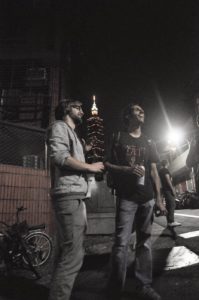We had two papers accepted at the 15th International Society for Music Information Retrieval Conference (ISMIR). Given the fantastic experience I had at ISMIR the year before, I was super-excited to travel to Taipei to attend the conference. The first of these papers is titled, “Multiple Viewpoint Melodic Prediction with Fixed-Context Neural Networks” and is in some ways a continuation of my work from the previous ISMIR conference. The abstract of the paper is as follows:
“The multiple viewpoints representation is an event-based representation of symbolic music data which offers a means for the analysis and generation of notated music. Previous work using this representation has predominantly relied on n-gram and variable order Markov models for music sequence modelling. Recently the efficacy of a class of distributed models, namely restricted Boltzmann machines, was demonstrated for this purpose. In this paper, we demonstrate the use of two neural network models which use fixed-length sequences of various viewpoint types as input to predict the pitch of the next note in the sequence. The predictive performance of each of these models is comparable to that of models previously evaluated on the same task. We then combine the predictions of individual models using an entropy-weighted combination scheme to improve the overall prediction performance, and compare this with the predictions of a single equivalent model which takes as input all the viewpoint types of each of the individual models in the combination.”
The paper was presented as a poster. The second paper is based on very interesting work I did in collaboration with Siddharth Sigtia and Emmanouil Benetos on automatic transcription of polyphonic music, titled “An RNN-based Music Language Model for Improving Automatic Music Transcription” that Siddharth presented as another poster.
I have to note that this year’s ISMIR organisation was fantastic! Everything from the review process, information on the website to the venue, the assitance at the venue, and the banquet were very well managed and executed by the organisers. The most interesting part of the conference for me was the keynote lecture, titled “Sound and Music Computing for Exercise and (Re-)habilitation” by Prof. Ye Wang, in which he described the potential in music to serve as a means to rehabilitate and improve the quality of life of individuals with different ailments, and illustrated this with the help of a few projects his group at the National University of Singapore has been working. It was a very inspiring talk, and I really admire Dr. Wang’s statement regarding the often overlooked direct impact of research and published work to society which has been the cornerstone of these projects. I have lately taken interest in Music Therapy and have been going through some literature to see if my own work on music modelling can in some way be applied to achieve therapeutic goals. There were some interesting late-breaking sessions as well that I took part in, including the very successful one organised by my supervisor Tillman on Big Data and Music where I was taking notes during the discussion.
And finally, as is always the case when I attend a conference, I did take some time off in Taipei and its surrounding areas. On one evening, I joined some friends and colleagues to go see the tallest building in the city – Taipei 101.

On another day, a couple of us planned a day-trip to a nearby village called Jiufen where we checked out some temples, the market and the old Japanese mining village on top of a hill.

And on another day, I joined my buddy Marius on a local site-seeing round to see some local museums, Shilin night market, Chiang Kai Shek Memorial, and other places before taking the long flight back to London eventually.
Taipei was fantastic, and I’d be up for another visit anytime! Last but not least, the hospitality of Fun Taipei hostel made the whole trip a little better each day.